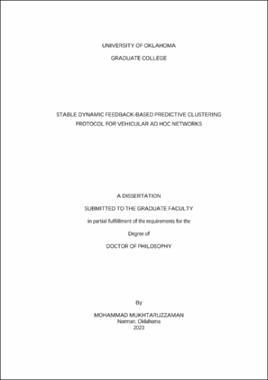| dc.description.abstract | Scalability presents a significant challenge in vehicular communication, particularly when there is no hierarchical structure in place to manage the increasing number of vehicles. As the number of vehicles increases, they may encounter the broadcast storm problem, which can cause network congestion and reduce communication efficiency. Clustering can solve these issues, but due to high vehicle mobility, clustering in vehicular ad hoc networks (VANET) suffers from stability issues. Existing clustering algorithms are optimized for either cluster head or member, and for highways or intersections. The lack of intelligent use of mobility parameters like velocity, acceleration, direction, position, distance, degree of vehicles, and movement at intersections, also contributes to cluster stability problems. A dynamic clustering algorithm that efficiently utilizes all mobility parameters can resolve these issues in VANETs.
To provide higher stability in VANET clustering, a novel robust and dynamic mobility-based clustering algorithm called junction-based clustering protocol for VANET (JCV) is proposed in this dissertation. Unlike previous studies, JCV takes into account position, distance, movement at the junction, degree of a vehicle, and time spent on the road to select the cluster head (CH). JCV considers transmission range, the moving direction of the vehicle at the next junction, and vehicle density in the creation of a cluster. JCV's performance is compared with two existing VANET clustering protocols in terms of the average cluster head duration, the average cluster member (CM) duration, the average number of cluster head changes, and the percentage of vehicles participating in the clustering process, etc. To evaluate the performance of JCV, we developed a new cloud-based VANET simulator (CVANETSIM). The simulation results show that JCV outperforms the existing algorithms and achieves better stability in terms of the average CH duration (4%), the average CM duration (8%), the number of CM (6%), the ratio of CM (22%), the average CH change rate (14%), the number of CH (10%), the number of non-cluster vehicles (7%), and clustering overhead (35%).
The dissertation also introduced a stable dynamic feedback-based predictive clustering (SDPC) protocol for VANET, which ensures cluster stability in both highway and intersection scenarios, irrespective of the road topology. SDPC considers vehicle relative velocity, acceleration, position, distance, transmission range, moving direction at the intersection, and vehicle density to create a cluster. The cluster head is selected based on the future construction of the road, considering relative distance, movement at the intersection, degree of vehicles, majority-vehicle, and probable cluster head duration. The performance of SDPC is compared with four existing VANET clustering algorithms in various road topologies, in terms of the average cluster head change rate, duration of the cluster head, duration of the cluster member, and the clustering overhead. The simulation results show that SDPC outperforms existing algorithms, achieving better clustering stability in terms of the average CH change rate (50%), the average CH duration (15%), the average CM duration (6%), and the clustering overhead (35%). | en_US |

